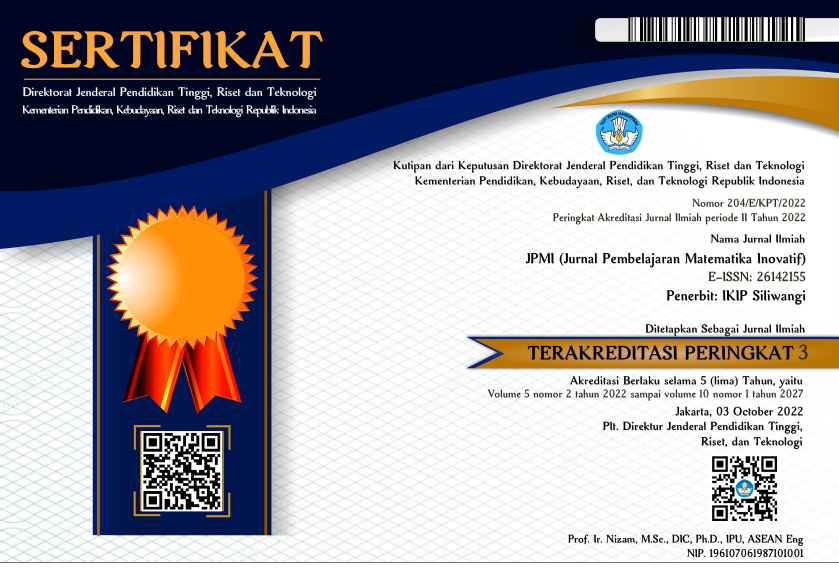Mendeteksi miskonsepsi bilangan bulat: Analisis proses berpikir mason berdasarkan kemampuan numerasi peserta didik
DOI:
https://doi.org/10.22460/jpmi.v8i4.27637Keywords:
Meta-analysis, Digital learning media, Critical thinkingAbstract
Students' low numeracy skills in understanding integer concepts often lead to misconceptions that frequently undetected, as they are embedded within students' cognitive processes rather than solely visible in final answers. This study aims to detect students' misconceptions in integer topics by analyzing their thinking processes using Mason's framework, based on their numeracy levels. This research employed a descriptive qualitative approach, involving six seventh-grade students from class VII at MTsN 8 Muaro Jambi. The subjects were classified into three numeracy categories: high, medium, and low. Data were collected through think-aloud-based diagnostic tests, in-depth interviews, and observations during problem-solving sessions. Data were then analyzed using Mason’s stages of thinking. The results showed that all students experienced theoretical and correlational misconceptions, while classification misconceptions were found only among students with low numeracy levels. Most errors occurred in the attack and review stages. Mason’s thinking framework proved effective in systematically identifying the location and type of misconceptions and provides a foundation for designing more targeted and responsive numeracy-based instructional strategies.
References
Ariany, R. L., Rosjanuardi, R., & Juandi, D. (2023). Penggunaan Zoom dan Google Classroom pada pembelajaran mikro terhadap kemampuan berpikir reflektif calon guru matematika. Seminar Nasional Pendidikan Dan Pembelajaran.
Creswell, J. W. (2015). Educational Reseacrh : Planning, Conducting, and Evaluating Quantitative, and Qualitative Research.
Fauziyah, N., Anam, A., & Aslikhatin. (2025). Analisis kemampuan pemecahan masalah numerasi siswa berdasarkan tahapan polya ditinjau dari gaya belajar. JPMI (Jurnal Pembelajaran Matematika Inovatif), 8(1), 91–106. https://doi.org/10.22460/jpmi.v8i1.25219
Goldstein, C., Woods, N., MacKinnon, R., Fazelzad, R., Gill, B., Giuliani, M. E., Papadakos, T., Wei, Q., & Papadakos, J. (2024). Numeracy Education for Health Care Providers: A Scoping Review. Journal of Continuing Education in the Health Professions, 44(1), 35–43. https://doi.org/10.1097/CEH.0000000000000504
Hidayah, N., Wulan, E. R., & Hamidah, D. (2022). KEMAMPUAN KONEKSI MATEMATIS SISWA DALAM MEMECAHKAN MASALAH HOTS LEVEL EVALUASI. Jurnal Pendidikan Matematika Universitas Lampung, 10(3), 290–306. https://doi.org/10.23960/mtk/v10i3.pp290-306
Hidayanto, E., Permadi, H., & Lestari, W. I. (2022). Thinking process of reflective impulsive cognitive style’s student to solving the mathematics problems. 030039. https://doi.org/10.1063/5.0102188
Indrawatiningsih, N., & Lestari, A. S. B. (2022). DEFRAGMENTİNG STUDENTS’ THİNKİNG STRUCTURE İN SOLVİNG MATHEMATİCAL ARGUMENTS. AKSIOMA: Jurnal Program Studi Pendidikan Matematika, 11(3), 2333. https://doi.org/10.24127/ajpm.v11i3.5061
Inganah, S., Vidyastuti, A. N., & Sah, R. W. A. (2023). High School Students’ Mathematical Skills in Addressing Minimum Competency Assessment Problems using Working Backward Strategy. AL-ISHLAH: Jurnal Pendidikan, 15(1), 999–1008. https://doi.org/10.35445/alishlah.v15i1.2454
Istinabila, A. F., & Fardah, D. K. (2022). MISCONCEPTION ANALYSIS OF STUDENTS WITH IMPULSIVE-REFLECTIVE COGNITIVE STYLE IN SOLVING PATTERNS OF NUMBERS PROBLEMS. MATHEdunesa, 11(2). https://doi.org/10.26740/mathedunesa.v11n2.pPDF_525-535
Kara, H. (2023). Qualitative data analysis. In Research and Evaluation for Busy Students and Practitioners (pp. 187–202). Policy Press. https://doi.org/10.51952/9781447366263.ch012
Kemendikbud. (2023). Rapor Pendidikan Indonesia.
Khalid, M., & Embong, Z. (2019). Sources and Possible Causes of Errors and Misconceptions in Operations of Integers. International Electronic Journal of Mathematics Education, 15(2). https://doi.org/10.29333/iejme/6265
Maknun, J., & Marwiah, M. (2022). Remediation of Misconceptions Vocational High School Students on the Concept of Static Fluids using the Conceptual Change Model. Journal of Technical Education and Training, 14(2). https://doi.org/10.30880/jtet.2022.14.02.005
Mason, J., Burton, L., & Stacey, K. (2010). Thinking Mathematically (2nd ed.). Pearson Education.
Nuringtyas, T., & Setyaningsih, N. (2023). Analisis kemampuan literasi matematika berbasis soal HOTS ditinjau dari kemampuan numerasi. Jurnal Cendekia: Jurnal Pendidikan Matematika, 7(2), 1211–1224.
Nusa, M. Y., Darwanto, & Handayani, R. (2023a). ANALISIS MISKONSEPSI MATEMATIKA POKOK BAHASAN OPERASI BENTUK ALJABAR PADA PROSES BERPIKIR MASON PADA SISWA KELAS VIII DI MADRASAH TSANAWIYAH NEGERI 1 LAMPUNG UTARA. Eksponen, 13(2), 104–113. https://doi.org/10.47637/eksponen.v13i2.894
Nusa, M. Y., Darwanto, & Handayani, R. (2023b). Analisis Miskonsepsi Matematika Pokok Bahasan Operasi Bentuk Aljabar Pada Proses Berpikir Mason Pada Siswa Kelas VIII di Madrasah Tsanawiyah Negeri 1 Lampung Utara. Eksponen, 13(2), 104–113. https://doi.org/10.47637/eksponen.v13i2.894
Permata, D., Wijayanti, P., & Masriyah. (2019). Students’ misconceptions on the algebraic prerequisites concept: causative factors and alternative solutions. Journal of Physics: Conference Series, 1265(1), 012005. https://doi.org/10.1088/1742-6596/1265/1/012005
Rahmah, F., Subanji, & Irawati, S. (2019). Mathematical representation analysis of students in solving mathematics problems. Journal of Physics: Conference Series, 1200, 012011. https://doi.org/10.1088/1742-6596/1200/1/012011
Rahmawati, R. D., Mardiyana, & Triyanto. (2019). Analysis of student misconception on calculus materials based on student mathematical reasoning. 020046. https://doi.org/10.1063/1.5141659
Reinhart, A., Evans, C., Luby, A., Orellana, J., Meyer, M., Wieczorek, J., Elliott, P., Burckhardt, P., & Nugent, R. (2022). Think-Aloud Interviews: A Tool for Exploring Student Statistical Reasoning. Journal of Statistics and Data Science Education, 30(2), 100–113. https://doi.org/10.1080/26939169.2022.2063209
Rosyidah, A. N. K., Maulyda, M. A., Jiwandono, I. S., Oktaviyanti, I., & Gunawan, G. (2021). Misconceptions and Errors in Integer Operations: A Study in Preservice Elementary School Teachers (PGSD). Journal of Physics: Conference Series, 1779(1), 012078. https://doi.org/10.1088/1742-6596/1779/1/012078
Setyaningsih, R., & Munawaroh, L. (2022). ANALISIS KEMAMPUAN LITERASI MATEMATIS SISWA DALAM MENYELESAIKAN SOAL BERORIENTASI PISA KONTEN UNCERTAINTY AND DATA. AKSIOMA: Jurnal Program Studi Pendidikan Matematika, 11(3), 1656. https://doi.org/10.24127/ajpm.v11i3.4948
Trisnaningtyas, N. O., & Khotimah, R. P. (2022). ANALISIS KEMAMPUAN LITERASI MATEMATIS DALAM MENYELESAIKAN SOAL AKM DITINJAU DARI GAYA BELAJAR. AKSIOMA: Jurnal Program Studi Pendidikan Matematika, 11(4), 2714. https://doi.org/10.24127/ajpm.v11i4.5662
Utami, N. P., Purwati, H., & Aini, A. N. (2023). Students’ Mathematical Literacy Ability in Comparative Material Viewed from Students’ Reasoning Ability. Phenomenon : Jurnal Pendidikan MIPA, 12(2), 188–205. https://doi.org/10.21580/phen.2022.12.2.11887
Zainudin, M., Kholiqul Amin, A., & Abdul Fatah, D. (2022). Understanding Elementary School Students’ Errors in Completing Number Operations. KnE Social Sciences. https://doi.org/10.18502/kss.v7i19.12478.
Downloads
Published
Issue
Section
License

This work is licensed under a Creative Commons Attribution-ShareAlike 4.0 International License.
The author is responsible for acquiring the permission(s) to reproduce any copyrighted figures, tables, data, or text that are being used in the submitted paper. Authors should note that text quotations of more than 250 words from a published or copyrighted work will require grant of permission from the original publisher to reprint. The written permission letter(s) must be submitted together with the manuscript.
















